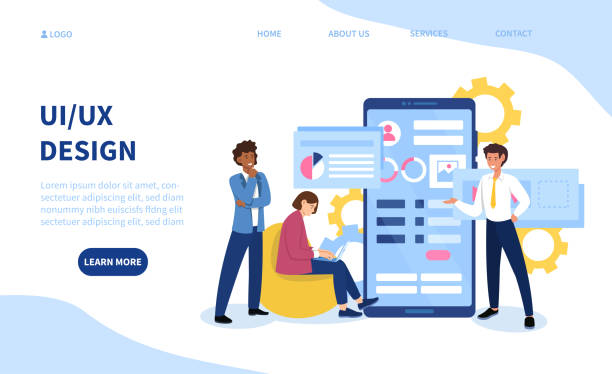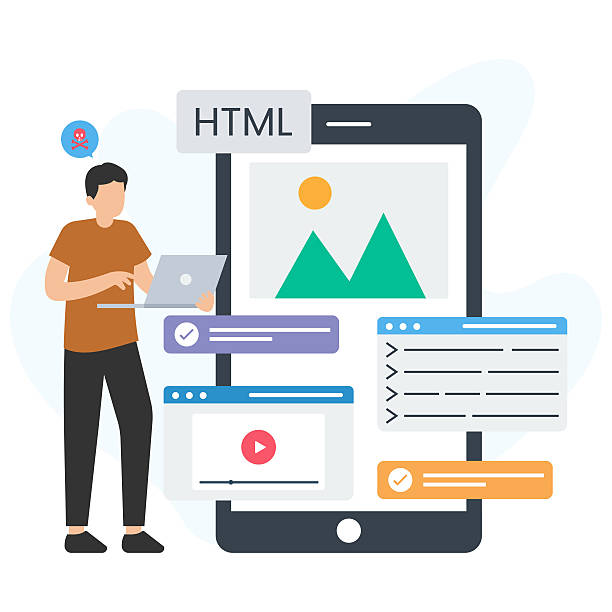An Introduction to Responsive Website Design: Why Should We Care About It?

In today’s digital world, where users access the internet from various devices such as mobile phones, tablets, laptops, and even smart TVs, #Web_Design has gained special importance.
One of the most significant challenges for web developers is providing a seamless and optimized experience for all these devices.
This is where the concept of Responsive Website Design comes in.
Responsive design means designing a website whose content and layout automatically adjust to the screen size of the user’s device, without the need to create separate versions for each device.
This approach not only significantly improves user experience but also plays a key role in SEO and increasing conversion rates.
Imagine a user visiting your website on their mobile phone; if the content is not displayed correctly, if they have to constantly zoom in, or if buttons are misplaced, they will quickly leave the site.
This is where the importance of #Website_Responsiveness and #Mobile_Friendly_Design becomes more prominent.
Responsive Web Design is a fundamental paradigm in modern web development that emphasizes flexibility and adaptability.
Its main goal is to ensure that a website is displayed optimally on any device, from the smallest smartphones to the largest desktop monitors.
This includes automatically adjusting font sizes, images, and the overall page layout to ensure usability and aesthetics.
Today, with the significant increase in mobile device usage for internet access, having a responsive website is no longer a luxury, but an absolute necessity.
In the following sections, we will delve into more details of this vital concept and see how these techniques can secure the future of your online presence.
Frustrated with your e-commerce site’s low conversion rate? RasaWeb transforms your online store into a powerful tool for attracting and converting customers!
✅ Significant increase in visitor-to-buyer conversion rate
✅ Unparalleled user experience to boost customer satisfaction and loyalty⚡ Get a free consultation from RasaWeb!
Why is Responsive Website Design Crucial Today? User Experience and SEO Benefits

In the current era, where most users access the internet via mobile devices, overlooking the importance of Responsive Website Design can mean losing a large segment of your audience.
Statistics show that over half of global web traffic originates from mobile devices.
If your website fails to provide an optimal user experience on these platforms, users will quickly leave it and move towards competitors who offer such features.
User Experience (UX) not only affects visitor satisfaction but is also directly linked to your website’s commercial success.
A website that displays well across all devices leads to increased user retention, reduced Bounce Rate, and ultimately, an increased Conversion Rate.
Beyond user experience, Responsive Website Design has a significant impact on Search Engine Optimization (SEO).
Google has explicitly stated that it prioritizes mobile-friendly websites in its rankings.
This means that if your website is not optimized for mobile, it may rank lower than your competitors in search results, even if your content is of higher quality.
Having a single version of your website that works well across all devices simplifies content management and link-building, and prevents duplicate content issues that might arise from having separate desktop and mobile versions.
This approach not only increases accessibility but also significantly reduces the workload for developers.
In fact, investing in Responsive Website Design is an investment in the future of your online business.
Key Principles and Techniques in Responsive Website Design

To effectively implement Responsive Website Design, web developers utilize a set of fundamental principles and techniques.
The core of this approach is the use of CSS Media Queries.
This CSS capability allows designers to apply different styles based on various screen characteristics such as width, height, orientation (portrait or landscape), and even resolution.
For example, it can be specified that on smaller screens, a columnar layout is applied instead of a grid layout.
Another fundamental principle is the use of Flexible Grids.
Instead of using fixed widths (pixels), responsive design uses relative units such as percentages.
This ensures that website elements automatically adjust their size with changes in screen width.
Similarly, Fluid Images are also of great importance.
By setting the maximum width (max-width) of images to 100%, it is ensured that images never overflow their container and scale up or down proportionally with the available space.
Furthermore, the ‘Mobile-First’ concept has become very popular in recent years.
In this approach, website design and development begins with the smallest screens (mobile) and then gradually expands to larger screens.
This ensures that performance and user experience are optimized on mobile devices, which have more constraints.
Additionally, optimizing fonts for readability across different sizes, using SVG (Scalable Vector Graphics) icons instead of pixel-based images, and focusing on user interface (UI) design for touch interaction are other key aspects of Responsive Website Design.
| Feature | Description | Application |
|---|---|---|
| Media Queries | CSS rules for applying styles based on screen characteristics | Changing layout and appearance for different devices |
| Flexible Grids | Using relative units (percentage) for layout | Automatic adjustment of element dimensions |
| Fluid Images | Images with max-width of 100% | Preventing images from overflowing their container |
| Mobile-First Approach | Designing first for smaller devices | Optimizing mobile performance and experience |
Evolution of Web Design Approaches with the Advent of Responsiveness

Before the advent of Responsive Website Design in the early 2010s, web developers were forced to create separate versions of their websites to support various devices.
This approach, often characterized by mobile-specific subdomains (such as m.example.com), brought with it numerous problems.
Maintaining two or more separate codebases for a single website significantly increased development cost and time.
Additionally, SEO optimization for these separate versions was more complex and carried the risk of creating duplicate content and reducing domain authority.
With the rapid expansion of smartphone and tablet usage, it became clear that this model no longer met the growing needs of users.
With the introduction of the concept of Responsive Website Design by Ethan Marcotte in 2010, a fundamental shift in web design approach took place.
The main idea was that instead of designing for specific devices, one should design for content that flexibly adapts to different environments.
This shift in perspective, from ‘fixed design’ to ‘fluid design,’ not only reduced the burden on developers but also significantly enhanced the user experience.
Now, there was no longer a need to change URLs or maintain multiple versions of a website; a single website could function well across all devices.
This transformation not only impacted development tools (such as CSS frameworks like Bootstrap and Foundation) but also reshaped how designers and information architects thought.
Designers began thinking about ‘content-first’ and ‘fluid user experience’.
This was a huge step forward that made the web a more flexible and accessible place for everyone.
Today, this approach is recognized as the industry standard, and rarely can a new website be found that is built without the principles of Responsive Website Design.
It was an evolutionary step towards achieving a global and integrated web.
Did you know that 94% of users’ first impressions of a business are related to its website design? With professional corporate website design by **RasaWeb**, turn this first impression into an opportunity for growth.
✅ Attract more customers and increase sales
✅ Build credibility and trust in the audience’s eyes⚡ Get a free website design consultation!
Challenges and Important Tips in Implementing Responsive Website Design

Implementing Responsive Website Design, despite its numerous advantages, is not without challenges.
One of the biggest obstacles is image management.
High-quality images optimized for desktop displays can slow down loading on mobile devices and disrupt the user experience.
To solve this problem, techniques such as ‘responsive images’ using srcset and sizes attributes in the img tag, or employing optimized image formats like WebP, are utilized.
These methods allow the browser to select the best image size for the user’s device, thereby improving loading speed and reducing bandwidth consumption.
Another challenge is managing navigation on mobile devices.
Large and complex menus that work well on desktop become unusable on small mobile screens.
Common solutions include using Hamburger Menus, dropdown menus, or tabbed navigation, which occupy less space and facilitate a touch-friendly user experience.
Also, website performance is extremely crucial.
Even an excellent Responsive Website Design will drive users away if it’s slow.
Optimizing CSS and JavaScript code, compressing files, and using Content Delivery Networks (CDNs) are among the essential measures for improving loading speed.
Furthermore, testing and validating Responsive Website Design across different devices and browsers is a major challenge in itself.
Given the countless variations in screen sizes and operating system versions, ensuring the correct functioning of a website in all scenarios is time-consuming and complex.
Browser simulation tools and testing on real devices are essential to ensure the final quality of work.
These points are vital for anyone intending to design a fully responsive website and require careful planning and correct execution.
Tools and Frameworks that Aid Responsive Website Design

To facilitate and accelerate the process of Responsive Website Design, numerous tools and frameworks have been developed to help developers create high-performance responsive websites in less time.
One of the most well-known and widely used of these frameworks is Bootstrap.
Bootstrap is a CSS, JavaScript, and HTML framework that includes a collection of UI components and a powerful, responsive grid system.
By providing predefined CSS classes, this framework allows developers to quickly implement responsive layouts without needing to write complex Media Queries from scratch.
Another framework that is highly popular in Responsive Website Design is Foundation.
Like Bootstrap, Foundation is a front-end framework that places a strong emphasis on the mobile-first approach and provides powerful tools for building responsive websites.
This framework is considered slightly more flexible than Bootstrap and is more suitable for projects requiring deep customization.
In addition to frameworks, various tools also exist for testing and debugging responsive websites.
Browser developer tools (such as Chrome DevTools) feature device simulation modes that allow developers to view and test their website across various screen sizes and in portrait/landscape modes.
Furthermore, online testing platforms like BrowserStack and CrossBrowserTesting enable developers to test their websites on real devices and various browsers, which is crucial for ensuring full compatibility of Responsive Website Design.
These tools significantly accelerate the development and quality assurance process.
The Impact of Responsive Website Design on Business and Conversion Rate

In the world of e-commerce and online presence, Responsive Website Design is no longer just a technical feature, but a critical factor for business success.
The direct impact of this type of design on Conversion Rate and company revenue growth is evident.
A website that displays correctly across all devices creates a positive user experience, leading to increased user trust, more time spent on the site, and ultimately, a greater inclination to perform a specific action (such as purchase, registration, or contact).
According to various reports, responsive websites have a lower Bounce Rate because users do not need to constantly adjust the screen to view content and can easily navigate the site.
This reduction in bounce rate means more user engagement with your content and services.
Furthermore, the improved SEO ranking achieved through Responsive Website Design leads to an increase in Organic Traffic and attracts more potential customers.
More traffic and a better user experience both directly contribute to an increased conversion rate.
Additionally, using a single website for all devices means saving on maintenance and development costs.
Instead of investing in multiple teams to maintain different versions, one team can focus on improving and updating a single website.
This frees up resources and allows businesses to focus on more critical aspects such as content creation or product development.
Ultimately, Responsive Website Design is not just a technical requirement, but a smart strategy for business growth and sustainability in today’s digital environment.
| Metric | Description | Impact of Responsive Design |
|---|---|---|
| Conversion Rate | Percentage of users who complete a desired action (e.g., purchase) | Significant increase with improved UX |
| Bounce Rate | Percentage of users who leave the site without interacting with the page | Noticeable decrease by providing a smooth experience |
| Time on Site | Average time users spend on the site | Increase due to better readability and ease of navigation |
| SEO Ranking | Website’s position in search engine results | Improvement with mobile-friendly capability |
| Maintenance Costs | Cost of managing and updating the site | Reduction by managing a single codebase |
Future Trends Beyond Mere Responsiveness

Although Responsive Website Design is recognized as a golden standard in modern web design, the web landscape is continuously evolving, and new trends beyond mere responsiveness are emerging.
One of these trends is Adaptive Design.
While responsive design is based on a fluid and flexible layout, adaptive design typically relies on a set of fixed layouts optimized for specific screen sizes.
This approach can sometimes offer more control over the user experience and lead to better performance, as only the resources required for the specific device are loaded.
Another important trend is the increasing focus on Performance and loading speed.
Even if a website is fully responsive, you will lose users if it takes too long to load.
Techniques like Progressive Web Apps (PWAs) and Accelerated Mobile Pages (AMP) aim to provide a faster, app-like experience on the web.
PWAs enable websites to have capabilities such as offline functionality, push notifications, and home screen installation, which elevate the user experience to a new level.
AMP, by simplifying HTML and CSS, makes page loading incredibly fast on mobile devices.
Furthermore, we are witnessing an increasing use of Artificial Intelligence (AI) and Machine Learning (ML) in optimizing user experience.
These technologies can personalize content based on user behavior and dynamically adjust the user interface.
This can take Responsive Website Design beyond merely adjusting layouts and guide it towards creating a truly personalized experience.
These developments indicate that future websites must not only look good on every device but also be smart, fast, and highly personalized.
Do you dream of a thriving online store but don’t know where to start?
RasaWeb is your comprehensive e-commerce website design solution.
✅ Attractive and user-friendly design
✅ Increased sales and revenue⚡ Get a free consultation
How to Ensure a Flawless User Experience with Responsive Website Design?

Ensuring a flawless User Experience (UX) on a website with Responsive Website Design goes beyond merely employing technical techniques; it requires a comprehensive and user-centric approach.
Firstly, user testing and feedback are crucial.
Instead of solely relying on browser simulators, the website should be tested on various physical devices and under different network conditions (such as 3G, 4G, Wi-Fi).
Gathering feedback from real users regarding usability and navigation can reveal hidden weaknesses.
Secondly, Performance Optimization is of paramount importance.
As previously mentioned, loading speed is critical for UX.
This includes image compression, optimizing CSS and JavaScript code, and utilizing caching and CDNs.
Every second of loading delay can lead to an increased bounce rate.
Using tools like Google PageSpeed Insights can help identify performance bottlenecks.
Thirdly, accessible and readable content is crucial.
Even if a website’s layout is responsive, if the text is too small, the color contrast is inadequate, or navigation is complex, the user experience will suffer.
Paying attention to Accessibility for users with special needs is also a vital aspect.
Ensuring that all users, regardless of their abilities or the device they use, can easily access your content demonstrates truly flawless web design.
Using appropriate typography, sufficient white space, and clear visual hierarchy aids readability and ease of content comprehension.
These steps ensure that your Responsive Website Design not only looks good but also offers high functionality and usability.
Analysis of Economic Benefits and ROI of Responsive Website Design

When businesses decide on Responsive Website Design, one of the key questions concerns its Return on Investment (ROI) and economic benefits.
Detailed analysis shows that investing in a responsive website quickly demonstrates its returns.
Firstly, the reduction in development and maintenance costs is significant.
Instead of developing and maintaining separate versions for desktop and mobile, a single website requires a single codebase, one development team, and an integrated SEO strategy.
This not only reduces costs but also simplifies the process of updating and adding new features.
Secondly, increased traffic and SEO ranking directly contribute to increased revenue.
Given that Google prioritizes mobile-friendly websites, a responsive website achieves higher rankings in search results, which translates to more visitors and, ultimately, more potential customers.
This organic traffic (without paying for ads) alone can provide significant value to a business.
Thirdly, improved user experience and conversion rate lead to increased sales and revenue.
Mobile users who have a frustrating experience with non-responsive websites typically leave them quickly.
In contrast, a responsive and optimized website encourages users to spend more time on the site, visit more pages, and increases the likelihood of making a purchase or contact.
This improvement in conversion rate directly impacts the business’s bottom line.
Overall, investing in Responsive Website Design is not only a technical requirement but also a smart strategic decision with positive and measurable financial returns that strengthens a business’s long-term value.
Frequently Asked Questions
| Question | Answer |
|---|---|
| What is Responsive Web Design? | It is a method of website design that optimizes the appearance and functionality of a website according to the screen size of the user’s device (mobile, tablet, laptop, etc.). |
| Why is responsive design important? | Due to the increasing use of various devices to access the internet, responsive design provides a better user experience, improves website SEO, and reduces maintenance costs. |
| What are the most important responsive design tools? | Media Queries in CSS, use of relative units (such as percentage, em, rem, vw, vh), Fluid Images, and Grid Systems. |
| What role do Media Queries play in responsive design? | Media Queries allow the application of different CSS styles based on device characteristics (such as screen width, height, orientation, and screen type). |
| What is the Mobile First concept in responsive design? | It is an approach where design and development begin with the smallest screen (mobile) and then gradually expand to larger screens (tablet, desktop). |
| Does responsive design affect SEO? | Yes, Google prefers responsive websites because they offer a better user experience and eliminate the need for separate mobile and desktop versions, which helps improve SEO ranking. |
| What does Fluid Layout mean? | It means that the width of page elements is defined using relative units (such as percentage) instead of fixed pixel values, so they automatically adjust with changes in screen size. |
| How are Flexible Images used in responsive design? | By setting the `max-width: 100%;` property for images in CSS, it is ensured that the image never exceeds its container and its scale is maintained with screen size changes. |
| What are the differences between responsive design and adaptive design? | Responsive design uses a single layout that fluidly adapts to any screen size, while adaptive design uses several fixed, predefined layouts for specific screen sizes. |
| Are CSS frameworks like Bootstrap useful in responsive design? | Yes, frameworks like Bootstrap have a responsive Grid System and pre-designed components that make the process of building responsive websites much simpler and faster. |
And other services of RasaWeb Advertising Agency in the field of advertising:
Smart Customer Journey Map: An innovative platform for improving online growth by optimizing key pages.
Smart Marketplace: A fast and efficient solution for digital branding with a focus on optimizing key pages.
Smart Direct Marketing: An effective tool for attracting customers with the help of Google Ads management.
Smart UI/UX: A professional solution to increase sales with a focus on attractive user interface design.
Smart UI/UX: Professional optimization for user interaction by customizing the user experience.
And over hundreds of other services in the field of internet advertising, advertising consulting, and organizational solutions.
Internet Advertising | Advertising Strategy | Advertorials
Sources
Comprehensive Guide to Responsive Design
Why is UX Crucial for Your Website?
Mobile-First Design: The Future of the Web
Best Tools for Responsive Web Design
? With RasaWeb Afarin, build the future of your business in the digital world. By offering innovative digital marketing solutions, from personal and corporate website design to SEO and targeted advertising, we help you keep your brand at the top. With us, have a powerful and influential presence in the online space.
📍 Tehran, Mirdamad Street, next to Bank Markazi, Southern Kazeroon Alley, Ramin Alley, No. 6



